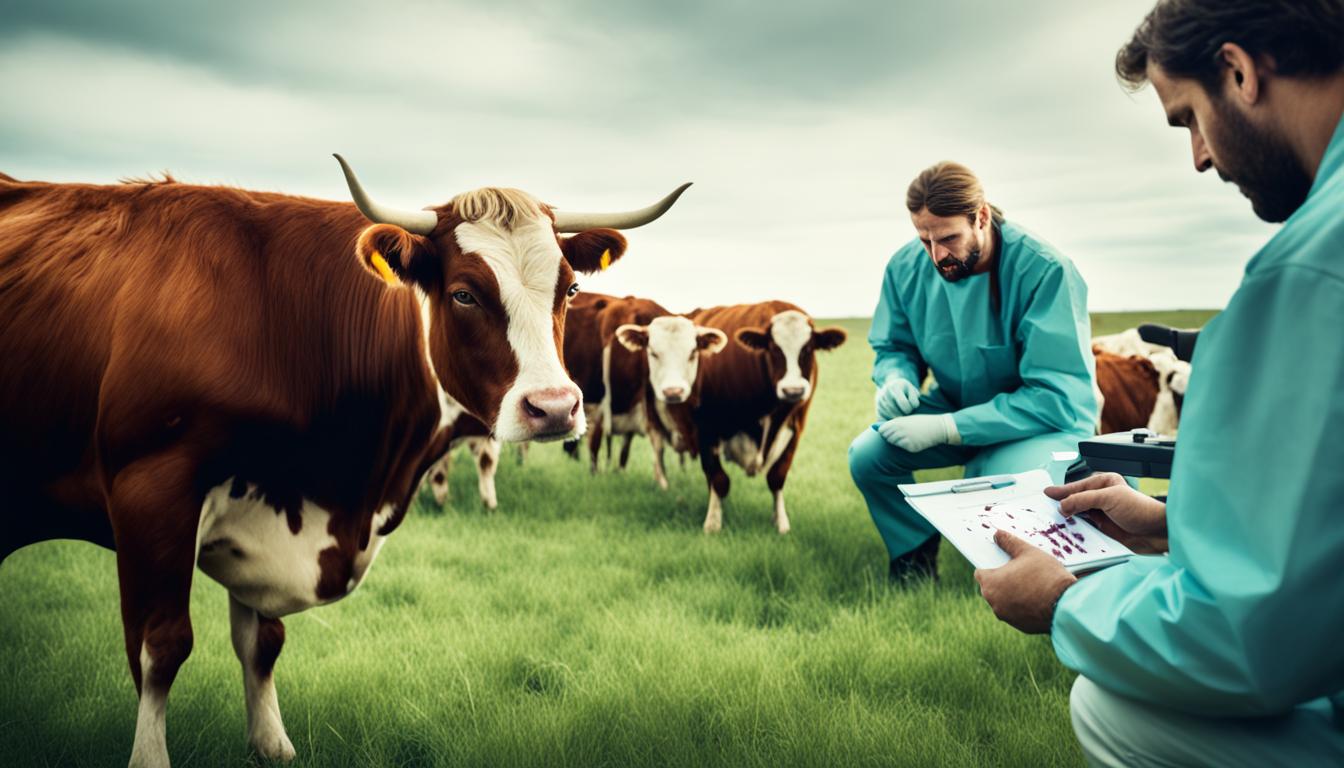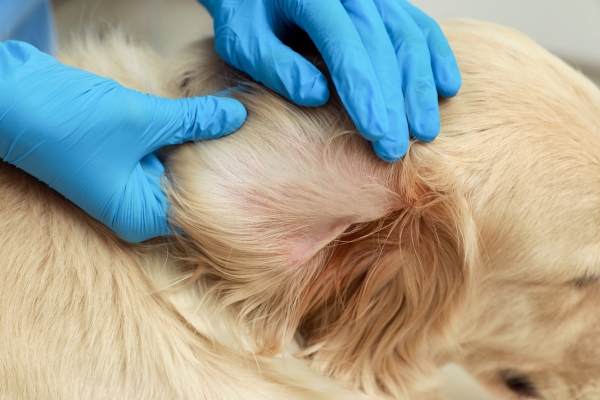Every year, an estimated $1 billion loss in the global livestock industry is attributed to cattle diseases spread by ticks, dramatically underscoring the critical impact of these parasites on animal health and agricultural economies.
Notably, recent attention has turned to the emergence of the aggressive Asian Longhorned tick, bringing new complexities to the management of tick-borne diseases in cattle. This introduction of advanced vectors has further amplified concerns among cattle producers, elevating the importance of effective tick control for cattle and timely cattle tick treatment protocols.
With the absence of approved treatments or vaccines for certain devastating conditions such as Theileria orientalis – a disease-causing anemia, fever, and reproductive issues – cattle farmers are forced to rely heavily on preventative measures and rigorous herd management to mitigate the risks posed by these tick-borne cattle diseases.
The challenge is substantial, but the necessity for action is clear: safeguarding cattle health is not only about curing diseases but crucially about controlling the ticks that carry them.
The Growing Threat of Theileria Orientalis in US Cattle
As the US cattle industry grapples with the emergence of Theileria orientalis, particularly the Ikeda genotype, the agricultural community faces significant challenges. Distinct clinical signs of this tick-borne parasite have been increasingly observed in US herds, raising alarm and demanding attention for its management.
Identifying the Clinical Signs of Theileria in Cattle
On-set symptoms can include anemia and the presence of pale gums, often coupled with fever and late-term abortions, which closely resemble those of the better-known tick-borne anaplasmosis in cattle. It’s crucial for cattle producers to recognize these signs early to manage Theileria effectively.
Comparing Theileria Symptoms to Anaplasmosis
The overlap of symptoms between Theileria and anaplasmosis poses a diagnostic dilemma. While both result in severe anemia and fever, timely analysis of blood smears and PCR testing are key to differentiating these diseases for targeted cattle tick prevention efforts.
Understanding the Impact of Asian Longhorned Ticks
The ability of Asian Longhorned ticks to reproduce rapidly and withstand traditional eradication methods contributes to the spread of Theileria. This tick’s resilience introduces further complexities in controlling the tick-borne fever in cattle and requires innovative preventative measures.
Challenges in Treating and Preventing Theileria
Efforts to combat Theileria are hindered by the absence of an approved treatment or vaccine. This complicates the struggle against Theileria orientalis, with the potential of leaving affected cattle as chronic carriers and risks the well-being of entire herds.
- Increased awareness of the clinical signs of Theileria.
- Confidently distinguishing Theileria from similar diseases like anaplasmosis.
- Adapting cattle tick prevention strategies to address the resilience of Asian Longhorned ticks.
The emphasis on education, awareness, and a proactive approach to prevention and control can help mitigate the risks associated with Theileria orientalis and safeguard the health of US cattle populations.
Cattle Diseases Spread by Ticks
As vectors of some of the most impactful livestock ailments, ticks pose a significant threat to cattle health and the agricultural economy. Understanding the scope of tick-borne pathogens in cattle and their subsequent economic impact is essential for developing effective preventive and control measures.

Overview of Common Tick-Borne Pathogens in Cattle
The peril of tick infestation in livestock primarily stems from the transmission of various pathogens. Key tick-borne diseases that afflict cattle include Babesia spp., Anaplasma marginale, and Theileria orientalis, each causing a spectrum of symptoms that disrupt bovine health and productivity.
- Babesia spp. lead to conditions like bovine babesiosis, manifesting as high fever, fatigue, and hemolytic anemia.
- Anaplasma marginale is notorious for causing anaplasmosis, which is marked by jaundice, rapid weight loss, and severe anemia.
- Theileria orientalis can induce theileriosis, resulting in pale mucous membranes, abortions in pregnant cows, and general decline in vigor.
The Economic Impact of Tick-Borne Diseases on Livestock Production
The economic impact of cattle diseases spread by ticks cannot be underestimated. Tick-borne diseases exert a significant burden on livestock producers, from the obvious costs of disease treatment and prevention to the less apparent but equally critical losses in production efficiency.
| Disease | Losses | Preventive Costs | Mortality Rate |
|---|---|---|---|
| Bovine Babesiosis | Decreased meat and milk yields | Vaccine, acaricide treatments | Varies, can be up to 30% in severe outbreaks |
| Anaplasmosis | Weight loss, lower milk production | Antibiotic therapy, tick control programs | 1-3% in enzootic areas, may be higher in epizootic events |
| Theileriosis | Reproductive losses, reduced growth rates | Monitoring and control strategies | Up to 5% but increases with mismanagement |
These diseases not only necessitate direct intervention but also incur secondary costs in terms of labor, reduced genetic potential, and opportunity losses when animals are unable to reach market size or reproductive status.
Therefore, an understanding of the full economic impact of cattle diseases is a cornerstone in the justification for investing in comprehensive tick management and disease prevention strategies.
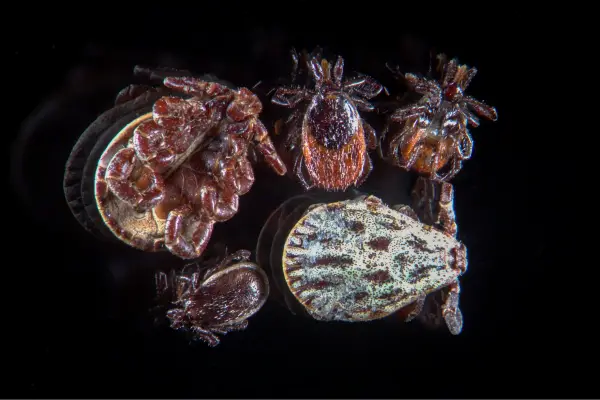
Advancements in Tick Control and Cattle Disease Prevention
The agricultural sector has made significant strides in tick control for cattle and tick-borne disease prevention. One of the most promising areas of innovation is the vaccine development aimed at mitigating the transmission of tick-borne diseases.
Cattle tick treatment products have also evolved, with advancements in acaricides that show increased efficacy against tick populations. Furthermore, understanding the cattle immune response has become a priority for researchers dedicated to improving herd health outcomes.
Strategic approaches integrating both chemical and immunological methods have been actively researched. Notably, investment in vaccine development for tick-borne diseases is gaining attention for its potential to revolutionize the field. Data indicates that these advancements could offer a viable pathway to protecting livestock from the rising threat of tick infestation and associated diseases.
The table below encapsulates current methodologies and their contributions to cattle health management:
| Method | Description | Benefits |
|---|---|---|
| Improved Acaricides | Chemical agents specifically designed to combat tick populations on cattle. | Directly reduces tick infestations and limits disease transmission. |
| Vaccine Development | Research focused on exploiting tick saliva proteins to create effective vaccines. | Prevents disease by targeting the biological process of vector-host transmission. |
| Immunological Control | Utilizing the cattle’s natural immune response to repel ticks and prevent infection. | Reduces chemical use and encourages sustainable livestock health management. |
| Integrated Management | Combines multiple control strategies to create a comprehensive tick management plan. | Tailored to specific herd needs, potentially more effective over the long term. |
Each of these emerging techniques reflects a commitment to both immediate efficacy and long-term sustainability in tick control and prevention strategies. Innovations in these areas are transforming how livestock producers approach the challenge of protecting their herds from tick-borne diseases.
Tick Saliva: A Vector for Transmitting Disease Pathogens to Cattle
The significance of tick saliva in the spread of pathogens to livestock reflects a remarkable facet of vector biology. Saliva from these tiny arachnids contains a complex cocktail of proteins specifically evolved to disarm the host’s defense mechanisms. This biological phenomenon not only allows ticks to feed undetected but also creates a pathway for disease transmission

The Role of Tick Saliva in Disease Transmission
Tick saliva serves as a potent facilitator in the spread of various pathogens into the bloodstream of cattle. Through their saliva, ticks deliver substances that can inhibit blood clotting, suppress the immune response, and increase blood flow to the bite site. Consequently, this creates an ideal environment for pathogens they carry, such as viruses, bacteria, and protozoa, to infect the host and lead to debilitating conditions.
Research on Tick Saliva Proteins and Vaccine Development
At the forefront of combating tick-borne disease vaccine development are scientific investigations centered on tick saliva proteins. Innovative proteomic techniques unravel the roles these proteins play and how they can be targeted to prevent cattle tick prevention. The endeavor to craft these vaccines stands as a hopeful milestone in not only curtailing the incidence of these diseases but also potentially eradicating them.
- Identifying saliva protein interactions with host immune systems
- Developing antigens for vaccine trials
- Assessing vaccine efficacy in controlled environments
By interrupting the mechanism of disease transmission at the source, these vaccines could transform the landscape of agriculture and livestock health management. The journey is complex, but the ingenuity and dedication of researchers promise a new chapter in tick-borne disease management.
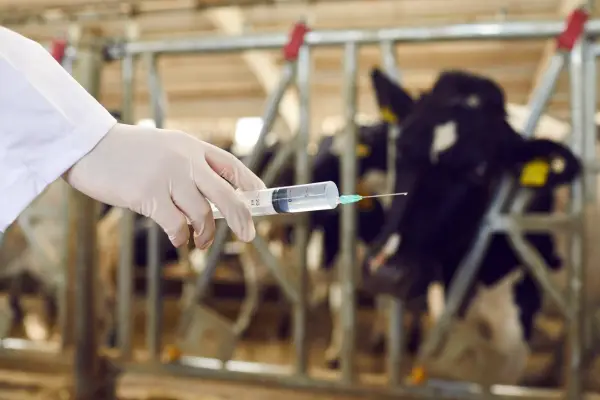
Strategies for Managing Tick Infestations in Livestock
Combatting tick infestation in livestock is an ongoing battle, one that requires an astute awareness of the challenges posed by acaricides and macrocyclic lactone resistance. Producers and veterinarians alike are turning towards integrated tick management strategies to preserve the health and productivity of livestock populations.
Conventional Acaricide and Macrocyclic Lactone Resistance
In the quest to shield livestock from tick-borne diseases, farmers have traditionally relied on acaricides. However, the emergence of acaricide resistance has diminished their effectiveness, propelling industry professionals to seek supplementary solutions.
Similarly, macrocyclic lactones, once a cornerstone for controlling parasitic infections, now face an invisible threat through the development of macrocyclic lactone resistance. The impact of such resistance not only jeopardizes animal health but also affects economic outcomes for farmers across the United States.
Integrated Management Approaches for Tick Population Reduction
The need for a holistic approach to manage and mitigate tick infestation in livestock has never been more apparent. It’s imperative that we adopt a multifaceted strategy, emphasizing the following components:
- ChemicalControl: Use of next-generation acaricides with careful attention to rotation and dosage to prevent resistance buildup.
- BiologicalControl: Introduction of natural tick predators or entomopathogenic fungi to suppress tick populations in pastures.
- PastureManagement: Regular maintenance of grazing areas to minimize tick habitats and potential exposure.
- Breeding Programs: Selective breeding of livestock showcasing inherent tick resistance, reducing the population’s overall susceptibility.
By weaving together these strands of integrated tick management, the agriculture sector can develop a resilient shield against the proliferation of ticks and the pathogens they carry.
| Integrated Tick Management Component | Benefits | Challenges |
|---|---|---|
| Chemical Control | Immediate reduction in tick populations. | Development of chemical resistance over time. |
| Biological Control | Environmentally friendly and sustainable. | Requires ecological balance, may be slow to take effect. |
| Pasture Management | Reduces tick habitat, limiting infestation opportunities. | Demanding in terms of labor and resources. |
| Breeding for Resistance | Long-term reduction in tick infestations and disease susceptibility. | Genetic diversity may be limited, lengthy process to establish. |
Tick-Borne Fever and Anaplasmosis: What Cattle Producers Need to Know
Tick-borne fever in cattle and tick-borne anaplasmosis in cattle are two significant health concerns that pose challenges to cattle disease management and necessitate stringent tick-borne pathogen control.
Both diseases are known for their detrimental effects on herd health and farm productivity, with symptoms that include severe anemia and high fever, often leading to death if left unmanaged. Early intervention through proactive measures can substantially mitigate the risks associated with these diseases.
Among the most critical steps in controlling these ailments is understanding their pathology, transmission modes, and the available preventative practices. To assist producers in identifying and combating these conditions effectively, here is a comprehensive overview:
- Recognition of clinical signs: Attention to symptoms such as high fever, lethargy, and yellowing of mucous membranes.
- Regular blood tests to monitor health: Early detection through diagnostic tests, including PCR for genetic material of pathogens.
- Control of tick populations: Utilizing acaricide treatments and implementing pasture management to reduce exposure to ticks.
- Vaccination protocols where applicable: Considering available vaccines as a component of an integrated disease management plan.
As each farm’s situation is unique, personalized management strategies that suit the specific conditions of the local environment, herd composition, and available resources are essential. Furthermore, ongoing education about tick-borne fever and anaplasmosis remains a cornerstone of effective disease prevention and control amongst cattle herds.
| Disease | Pathogen | Primary Symptoms | Control Strategies |
|---|---|---|---|
| Tick-borne Fever | Rickettsia bacteria | Anemia, Fever, Weakness | Tick control, Environmental management |
| Anaplasmosis | Anaplasma marginale | High fever, Jaundice, Severe anemia | Vaccination (where available), Blood tests, Acaricides |
It is the responsibility of cattle producers to remain vigilant for these tick-borne diseases and implement a multi-faceted approach for their control. By doing so, they protect the welfare of their herds and the sustainability of their agricultural enterprise.
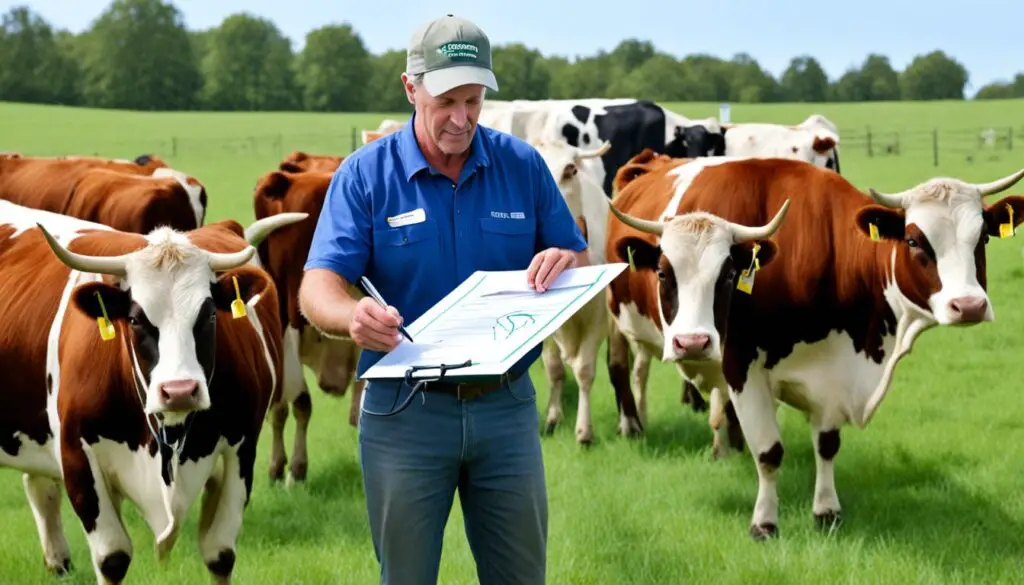
Global Distribution and Spread of Tick-Borne Diseases
The relentless march of tick-borne diseases across the globe represents a complex challenge exacerbated by environmental changes and the mobility of human and animal populations.
Notably, the Asian longhorned tick, a relatively recent invader in some regions, is becoming increasingly notorious for its capacity to transmit diseases such as Theileria orientalis, an affliction that imperils livestock industries worldwide.
With the global distribution of tick-borne diseases on the rise, key players in health and agriculture are urgently seeking effective monitoring and containment strategies to halt the tick-borne disease spread. The dynamic nature of pathogen landscapes, rhythmically attuned to the impacts of climate change on pathogens, calls for cutting-edge approaches and international collaboration.
Monitoring and Containing the Spread of the Asian Longhorned Tick
Surveillance activities intensify as the Asian Longhorned tick forges new territories, raising alarms among livestock producers and public health officials alike. Concerted efforts focus on tracking the tick’s migration patterns and curtailing its proliferation.
Adapting to New Pathogen Landscapes Due to Climate Change
Climate change undeniably influences the habitats and behaviors of ticks, prompting the need for robust adaptation measures. By anticipating the shifts in climate, stakeholders can develop proactive strategies to defend against the burgeoning threat of tick-borne diseases.
| Region | Tick Species | Diseases Identified | Adaptation Strategy |
|---|---|---|---|
| North America | Asian Longhorned tick | Theileria orientalis | Enhanced veterinary surveillance |
| Europe | Ixodes ricinus | Lyme disease, Tick-borne encephalitis | Public awareness campaigns |
| Asia-Pacific | Haemaphysalis longicornis | Severe fever with thrombocytopenia syndrome (SFTS) | Wildlife population control |
| Africa | Rhipicephalus appendiculatus | East Coast fever | Climate-resilient livestock breeds |
Addressing the intersection of tick proliferation and climate dynamics is central to safeguarding agricultural interests and public health. As research continues to refine our understanding of these factors, the onus is on proactive preparation—leveraging current knowledge to craft robust defenses against the insidious advance of tick-borne ailments.
Understanding and Harnessing Immunological Responses in Cattle
In the pursuit of cattle tick prevention, significant advancements in tick vaccine research have underscored the importance of harnessing cattle immunological responses.
By delving into the mechanisms behind these responses, scientists are developing innovative strategies that could revolutionize livestock disease control. By leveraging a cow’s natural defense systems against tick-borne pathogens, the livestock industry can minimize reliance on chemical interventions.

Current research efforts focus on pinpointing and replicating the biological processes that cattle utilize to ward off ticks naturally. Identifying the genetic markers that contribute to an individual cow’s resistance to ticks offers a springboard for breeding programs.
Concurrently, studying the immune responses to tick bites not only aids in creating targeted vaccines but also enhances the understanding of how cattle can combat these pests internally.
- Identification and mapping of bovine immune factors related to tick resistance.
- Developing vaccines that trigger specific immune responses to prevent tick attachment and feeding.
- Exploring methods to bolster cattle’s inherent immune defenses through nutritional and genetic strategies.
The implication of this research holds promising potential for safeguarding cattle health and promoting sustainable farming practices.
With ticks responsible for the transmission of numerous pathogens causing diseases with profound economic impact, the agricultural sector recognizes the imperative of a paradigm shift towards biologically-based tick control methods.
Diagnostic Tools and Technologies for Detecting Tick-Borne Diseases
The battle against tick-borne diseases in cattle has advanced significantly with the integration of sophisticated diagnostic tools. These technologies not only enhance the ability to spot infections early but also empower veterinarians and farmers with the knowledge needed to implement appropriate treatments and control strategies.
Enhancing Disease Surveillance through Molecular Diagnostics
The advent of molecular diagnostics has revolutionized the detection and surveillance of tick-borne diseases. Methods like the polymerase chain reaction (PCR) facilitate the quick identification of pathogens at a molecular level, enabling farmers to address tick-borne disease identification with a new level of precision.
Importance of Accurate Disease Identification for Effective Treatment
Accurate identification of tick-borne pathogens is a pivotal element in determining treatment effectiveness. With timely and precise detection methods, cattle can receive appropriate interventions, minimizing potential health risks and preventing the spread of diseases within the herd.
| Disease | Diagnostic Tool | Pathogen Detected | Usability in Field |
|---|---|---|---|
| Anaplasmosis | PCR Testing | Anaplasma marginale | High |
| Bovine Babesiosis | ELISA | Babesia spp. | Moderate |
| Theileriosis | PCR and Blood Smear | Theileria orientalis | High |
The table above showcases how different diagnostic tools for tick-borne diseases cater to the detection of various pathogens that affect cattle. These methodologies, primarily revolving around molecular diagnostics, have become invaluable assets in managing the health of livestock and safeguarding the cattle industry from the escalation of tick-related afflictions.
Conclusion
As we look toward the horizon of cattle disease management, the weight of tick-borne diseases on the livestock industry cannot be understated. With the advancement of research and technology, the future of tick-borne disease vaccination is poised to become a cornerstone in our defense against these pervasive threats.
Vaccines are under development, promising a layer of protection that could transform livestock health protection. Yet, alongside these scientific endeavors, robust cattle disease control measures must remain a priority for immediate impact, emphasizing the importance of integrated management strategies to safeguard our herds.
Preparing for the Future: Vaccination and Control Measures
The battle against tick-borne diseases is multifaceted, marrying the promise of modern science with the practicality of traditional herd management techniques. Anticipation of effective vaccines brings hope, projecting a scenario where the reliance on chemical acaricides could decrease, thereby mitigating resistance issues.
Research challenges in tick-borne diseases persist, however, as scientists aim to crack the code of immune response manipulation and tailor vaccinations that are both broadly protective and economically viable.
Addressing the Challenges in Tick-Borne Disease Research
Collaboration is the lifeline of innovation in this field. Combining the expertise of researchers, the practical knowledge of veterinarians, and the firsthand experiences of cattle producers fosters an environment where breakthroughs can occur.
Complexities in pathogen-host interactions, varying ecological conditions, and the unpredictability of vector populations demand a nuanced approach to livestock health protection. Addressing these challenges head-on will be the fulcrum on which the livestock industry’s resilience will balance in the years to come.

